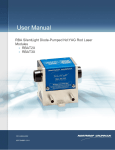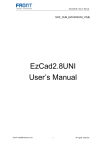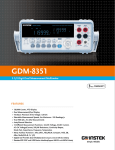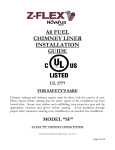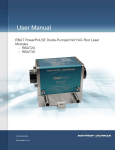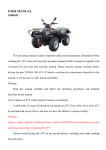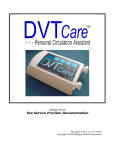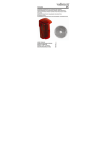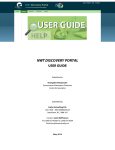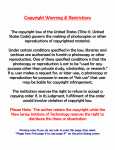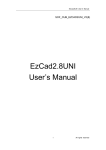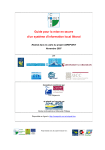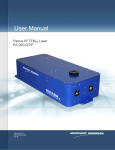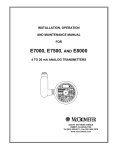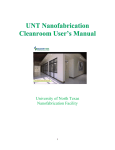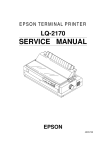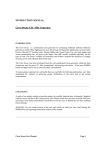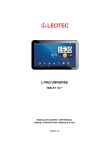Download Us ser M Man ual - CEO Knowledge Center
Transcript
Us ser Man M ual RBA A SilentL Light Diode-Pumped Nd:YAG G Rod Laser Mod dules RBAT2 2X 3X RBAT3 CEO-UM MAN-0062 Rev A SEPTEM MBER 2014 uble Shootin ng Guid Worldwide Technical Support and Product Information http://www.northropgrumman.com/BusinessVentures/CEO/Pages/Service.aspx Hours: 8:00 a.m. to 5:00 p.m., Central time* Technical Support: (636) 916-4900 (follow prompts for department directory) Email: [email protected] Cutting Edge Optronics Headquarters 20 Point West Blvd. St. Charles, MO 63301 USA Sales Support: (636) 916-4900 (follow prompts for department directory) *After office hours, please leave a voice mail message. Outside North America, contact a Cutting Edge Optronics sales office or distributor; see the Cutting Edge Optronics website for a list of offices. © 2014 Cutting Edge Optronics, a strategic business unit of Northrop Grumman Systems Corporation. All rights reserved. © 2014 Northrop Grumman Systems Corporation ii RBAT User Manual Important Information Warranty Summary Northrop Grumman Cutting Edge Optronics (NG CEO) warrants that the products that it manufactures and sells will be free from defects in materials and workmanship for a period of one year from the date of shipment from an NG CEO distributor. If a product proves defective within the respective period, NG CEO will provide repair or replacement as described in the complete warranty statement. To arrange for service or obtain a copy of the complete warranty statement, please contact your nearest NG CEO sales and service office. EXCEPT AS PROVIDED IN THIS SUMMARY OR THE APPLICABLE WARRANTY STATEMENT, NG CEO MAKES NO WARRANTY OF ANY KIND, EXPRESS OR IMPLIED, INCLUDING WITHOUT LIMITATION THE IMPLIED WARRANTIES OF MERCHANTABILITY AND FITNESS FOR A PARTICULAR PUPOSE. IN NO EVENT SHALL NG CEO BE LIABLE FOR INDIRECT, SPECIAL, OR CONSEQUENTIAL DAMAGES. Copyright Under the copyright laws, this publication may not be reproduced or transmitted in any form, electronic or mechanical, including photocopying, recording, storing in an information retrieval system, or translating, in whole or in part, without the prior written consent of NG CEO. Trademarks eDrive and SilentLight are registered trademarks of Northrop Grumman Corporation. Patents Northrop Grumman Corporation products are covered by U.S. and foreign patents, issued and pending. Information in this publication supersedes that in all previously published material. Specifications and price change privileges reserved. © 2014 Northrop Grumman Systems Corporation iii RBAT User Manual Safetyy Information n P Product End-of-Life E e Handling g NG CEO is committeed to protectiing the envirronment. In accordance with the Waaste Electricall and Electro onic Equipm ment directivee (WEEE) annd Restrictioon of Hazarddous Substancees in the Eurropean Union (RoHS EU U) directivess, NG CEO aaccepts the rreturn of our produ ucts for dispo osal. When you y are readdy to reclaim m the instrum ment, you muust properly transfer t it acccording to local regulatiions concernning WEEE equipment. Contact NG CEO or your loccal distributo or for shippinng instructioons. Please ppackage the pproducts as directeed for a returrn for repair. R ROC ROHS Declaration D In n accordance with the Claause 6.2 of M Marking for Control of P Pollution Caaused by Ellectronic Info formation Pro oducts (SJ/T T11364:20066) for Measuures for the Ad dministration n on Pollutio on Control oof Electronicc Informationn Products N No. 39, Orrder of the Ministry M of In nformation IIndustry of tthe Peoples R Republic of China, NG G CEO inclu udes the folllowing transllation aboutt our laser modules. © 2014 Norrthrop Grumm man Systems Corporation C iv RBAT Use er Manual Conventions The following conventions appear in this manual: This icon denotes a caution or a warning, which advise you of precautions to take to avoid injury, data loss, or a system crash. Initial Capped The first letter in uppercase refers to menu options, e.g., Phase Delay, Pulse Width. CAPS Front-panel buttons, knobs, and connectors appear in all uppercase letters, e.g., MENU, CURRENT. The symbol separates a sequence of button pushes, e.g., MENU CHANNEL SETUP PULSE WIDTH means that you push the MENU button, then push the CHANNEL SETUP soft key, and then push the PULSE WIDTH soft key. italic Italic text denotes references to other resources that may be helpful to you or to bring attention to important information. This icon denotes a note, which alerts you to important information. I O Power Switch Position Symbols I = On O = Off The following conventions may appear on the product: DANGER An injury hazard immediately accessible as you read the marking. WARNING A hazard not immediately accessible as you read the marking. CAUTION A hazard to property including the product. ESD: Handle Appropriately © 2014 Northrop Grumman Systems Corporation v RBAT User Manual Laser Emission: Use caution. Shock Hazard: Use caution. Caution: Risk of danger. Refer to manual. Chassis Ground © 2014 Northrop Grumman Systems Corporation vi RBAT User Manual General Safety Summary The RBA Silent Light module emits laser radiation that can permanently damage eyes and skin, ignite fires, and vaporize substances. The Laser Safety section (Chapter 2) contains information and guidance about these hazards. To minimize the risk of injury or expensive repairs, carefully follow these instructions. Do not open the factory packaging before carefully reading this complete operation and maintenance manual. If you have any questions on the product which have not been discussed sufficiently within the manual, contact the manufacturer for complete instructions. Failure to heed this warning may result in the destruction or serious damage to the device, and will void the product warranty. The Service section is intended to help guide you to the source of problems. Do not attempt repairs while the unit is under warranty; instead, report all problems to NG CEO for warranty repair. Use the form in Appendix A: Customer Service to describe issues with the module. We also suggest that you record information about the module such as power, settings, time and date. © 2014 Northrop Grumman Systems Corporation vii RBAT User Manual About this Manual This manual describes the installation, operation, and service of the RBA Silent Light module. The manual consists of the following chapters: Chapter 1: Introduction provides a theory of operation description of the module and specifications Chapter 2: Laser Safety describes proper safety procedures you should understand before operating the module. Chapter 3: Module Details provides information about unpacking, storing and proper environmental conditions for operation. Chapter 4: Installation and Operation discusses how to setup your module and powering on your system for the first time. Chapter 5: Maintenance provides information on proper maintenance of your module. Chapter 6: Service provides resources to help fix problems with the RBA Silent Light module Appendix A: Customer Service provides information to expedite any service request before contacting NG CEO. Appendix B: System International Units identifies commonly used units of measurement found in this manual. Appendix C: Acronyms provides a list of commonly used abbreviations and their descriptions used throughout this manual. © 2014 Northrop Grumman Systems Corporation viii RBAT User Manual Table of Contents Chapter 1: Introduction 1 Theory of Operation 1 Temperature Tuning of Laser Diodes 2 RBA Silent Light Description 4 Closed Loop Re-circulating Distilled Water Chiller 4 Specifications 6 Chapter 2: Laser Safety 8 Caution & Warning Statements 9 Precautions for Safe Operation of Class IV Lasers 10 Center for Devices and Radiological Health (CDRH) OEM Product 11 Safety Device Checklist 12 Chapter 3: Module Details 13 Unpacking your Module 14 RBA Silent Light Module 15 Storing the RBA Silent Light 17 Closed Loop Chiller 17 Chapter 4: Installation and Operation 23 RBA Silent Light Laser Module Assembly and Connections 24 Closed Loop Chiller Assembly 26 Starting the Laser Module 27 Standby Condition 29 Turning Off the System 29 © 2014 Northrop Grumman Systems Corporation ix RBAT User Manual Chapter 5: Maintenance 30 Rod Removal and Replacement 31 Leak Test Procedure 33 Rod Cleaning 34 Adjusting the Operating Current 34 Cleaning the Chiller 35 Chapter 6: Service 37 Contacting Customer Service 38 Return the Instrument for Repair 38 Appendix A: Customer Service 39 Questions 40 Appendix B: System International Units 42 Appendix C: Acronyms 43 © 2014 Northrop Grumman Systems Corporation x RBAT User Manual Table of Figures Figure 1-1 Exterior Components and Connections 2 Figure 1-2 Nd:YAG Absorption Characteristics 3 Figure 1-3 Pump Light Absorption vs. Pump Array Center Wavelength 4 Table 1-1 NG CEO Recommended Chiller Table 5 Table 1-2 RBAT Series Model Specifications1 6 Table 1-3 RBAT General Specifications 7 Figure 2-1 Standard Safety Warning Sign 11 Figure 2-2 Radiation Control Drawing 12 Figure 2-3 Warning Labels 12 Figure 3-1 RBAT with Ring Tongue Terminals 15 Figure 3-2 Reverse Bias Protection Diode Circuit 16 Table 3-1. Cooling System Requirements 18 Table 3-2. Avoid with Chillers 18 Figure 3-3. Constant Dew Point Lines for Ambient Temperature and Relative Humidity 21 Table 3-3. Table of Air Condensation Temperature at Given Ambient Air Temperature (Celsius) and Relative Humidity (percent) 22 Figure 4-1 Connection Diagram 25 Figure 4-2 eDrive Rear Panel 25 Figure 4-3 Chiller Assembly Drawing 26 Figure 5-1 Rod Replacement Drawing 31 Figure 5-2 Nitrogen Leak Test Layout 34 © 2014 Northrop Grumman Systems Corporation xi RBAT User Manual 1 Chapter 1: Introduction This introduction provides the following information: Theory of Operation Temperature Tuning of Laser Diodes RBA Silent Light description Closed Loop Re-circulation Distilled Water Chiller Specifications © 2014 Northrop Grumman Systems Corporation 1 RBAT User Manual Chapter 1: Introduction Theory of Operation The RBA Silent Light module was designed for use as a building block “engine” in the development or production of medium power rod laser systems or as a drop-in replacement for arc lamp pump chambers in industrial lasers. It is well suited for medium power applications such as laser marking, and can provide high stability and beam quality for more precise micro-machining and scientific applications. NG CEO diode pumped, solid-state lasers and pump modules use temperaturetuned GaAlAs laser diodes. These diodes replace arc lamps or incandescent light sources as the optical pump source. The principal advantages of this approach include: Longer lifetime More compact size More efficient operation The RBA Silent Light module is available in Nd:YAG with the laser rod AR coated for the highest gain wavelength of this material, 1064 nm. (NG CEO also offers the RBA Silent Light with a Nd:YLF rod. Throughout this manual, we will refer only to the Nd:YAG laser medium.) The RBA Silent Light module is constructed within a durable and rigid structure. Exterior components and connections are shown in Figure 1-1. The diode optical output power is radially coupled into the laser rod. © 2014 Northrop Grumman Systems Corporation 1 RBAT User Manual Chapter 1: Introduction Figure 1-1 Exterior Components and Connections Temperature Tuning of Laser Diodes The laser diodes are located within the RBA Silent Light module and tuned, wavelength matched, via the closed loop chiller. For maximum efficiency, the diode output wavelength must match the laser medium absorption characteristics (see Figure 1-2). The output spectrum of a conventional pump source for Nd:YAG operation, the xenon arc lamp, and 808 nm diode array is also shown. © 2014 Northrop Grumman Systems Corporation 2 RBAT User Manual C Chapter 1: Introduction Figure 1-2 Nd:YA AG Absorption Chharacteristics A single GaAllAs laser dio ode bar has a 2 nm FWH HM distributiion of outpuut waavelengths. However, H th he process ussed in the maanufacture oof GaAlAs laaser diodes results in a peak ou utput waveleength for eacch diode thatt fits within a 10 nm distribution off wavelength hs from 800--810 nm. To match the ddiode output to an ab bsorption peaak of the laseer medium, diodes are seelected withh similar peakk output waavelengths within w the maanufacturingg range. Tem mperature tunning is possiible beecause GaAlAs diode ch haracteristicss are such thaat 0.25 nm oof wavelengtth shift occcurs for eveery 1oC chan nge in temperrature of thee diode juncttion. Coolingg sh hortens the wavelength, w and a heating llengthens it.. Figure 1-3 shows the peercentage of pump light of o different w wavelengthss absorbed bby two passes thrrough a 6.35 5 mm thick rod r of 0.6% doped Nd:Y YAG. In NG CEO modulles, the lasser diode cen nter wavelen ngth, under nnormal operaating conditiions, is nearr the ab bsorption peaak of the laseer medium. The operatinng temperatuure of closedd loop ch hiller is careffully chosen to shift the ddiode tempeerature, so thhat the wavellength matches the ab bsorption peeak. The finaal test report,, included w with each module, indicates the optimum o opeeration tempperature for tthat module. © 2014 Norrthrop Grumm man Systems Corporation C 3 er Manual RBAT Use C Chapter 1: Introduction Figure 1-3 Puump Light Absorpption vs. Pump A Array Center Waavelength R RBA Silent Ligh ht Descrription Th he RBA Sileent Light mo odule utilizess a radial puump geometrry to excite tthe solidstaate laser med dium. This pump p geomeetry results inn excellent ggain uniform mity and len nsing perforrmance. The reflector dirrects the diveergent diodee light back tto the lasser medium,, which is keept in a flow tube for cooolant circulaation. The lasser medium is a ro od of neodym mium-dopedd yttrium aluuminum garnnet (Nd:YAG G). Both en nds of the rod d are opticallly polished and include anti reflectioon coatings at the lassing wavelen ngth. The en nds of the N Nd:YAG rod may be curvved to compensate for thermal len nsing, depen nding on moddule configuuration. Th he RBA Sileent Light is available a in tthree physicaal sizes: Thee short versioon of the RB BA Silent Liight is availaable in 3, 6, 9, and 18 diode bar verssions. The m midlen ngth model is i a 12 diodee bar model, and the longg model hass 15 diode baars. Each off the various versions is available a wiith either a 2 mm or a 3 m mm diameteer rod of Nd d:YAG in th he appropriatte length. Seee Table 1-2 for module dimensions and sp pecifications. C Closed Loop Ree-circulaating Diistilled W Water C Chiller Th he module co oolant loop is i designed ffor an operat ating pressuree of 50 psi. C Chillers wh hich deliver the required d flow rate att lesser presssure do not pprovide adeqquate co ooling. The selected s chilller must havve a heat cappacity of greaater than thee waste heeat for the sp pecific modeel of RBA Siilent Light m module. Depeending on thhe model © 2014 Norrthrop Grumm man Systems Corporation C 4 er Manual RBAT Use Chapter 1: Introduction of RBA Silent Light, the module dimensions, rod size, output power, and power consumption varies. Therefore, NG CEO recommends different model of chiller depending on the number of diode bars in a module and the local electricity which will power the chiller. The following table (Table 1-1) gives the NG CEO recommendations. Table 1-1 NG CEO Recommended Chiller Table Model RBATx0-0.33C2 RBATx0-0.66C2 RBATx0-1C2 RBATx4-1C2 RBATx5-1C2 RBATx0-2C2 RBATx0-1C4 RBATx4-1C4 RBATx5-1C4 Model RBATx0-0.33C2 RBATx0-0.66C2 RBATx0-1C2 RBATx4-1C2 RBATx5-1C2 RBATx0-2C2 RBATx0-1C4 RBATx4-1C4 RBATx5-1C4 60 Hz Electrical Outlets EOL Waste Polyscience Chiller Current Heat No. 32 A 212 W 6262T31CE10B 32 A 425 W 6262T31CE10B 32 A 635 W 6262T31CE10B 32 A 845 W 6362T31CE20C 32 A 1060 W 6362T31CE20C 32 A 1267 W 6762T41CE30D 47 A 931 W 6362T31CE20C 47A 1241 W 6762T41CE30D 47 A 1551 W 6762T41CE30D 50 Hz Electrical Outlets EOL Waste Polyscience Chiller Current Heat No. 32 A 212 W 6252T41CE30E 32 A 425 W 6252T41CE30E 32 A 635 W 6352T41CE30E 32 A 845 W 6352T41CE30E 32 A 1060 W 6752T41CE30E 32 A 1267 W 6752T41CE30E 47 A 931 W 6352T41CE30E 47 A 1241 W 6752T41CE30E 47 A 1551 W 6752T41CE30E © 2014 Northrop Grumman Systems Corporation 5 Chiller Capacity 800 W 800 W 800 W 1200 W 1200 W 2500 W 1200 W 2500 W 2500 W Chiller Capacity 664 W 664 W 996 W 996 W 2075 W 2075 W 996 W 2075 W 2075 W RBAT User Manual Chapter 1: Introduction Specifications RBA Silent Light modules are tested to exceed the following specifications. The standard production test configuration consists of a 165 ± 5 mm cavity utilizing a 0.75 mcc high reflector and a flat 80% reflective output coupler. The RBAT200.33C2 requires a modified test configuration with a 90% reflective output coupler. Table 1-2 RBAT Series Model Specifications1 MODEL Output Power2 (W) Rod Size (mm) Diode Bias Voltage @ 25 Amps (VDC) Power Consumption3 (W) Module Dimensions MODEL Output Power2 (W) Rod Size (mm) Diode Bias Voltage @ 25 Amps (VDC) Power Consumption3 (W) Module Dimensions 0.33C2 10 RBAT200.66C2 1C2 2C2 20 35 50 1C4 50 RBAT301C2 2C2 1C4 50 2 x63 75 75 3 x 63 6 12 18 36 18 18 36 18 200 400 600 1200 935 600 1200 935 2.6 H x 1.82 W x 3.07 L inches RBAT241C2 RBAT34- RBAT34- RBAT25- RBAT35- RBAT351C2 1C4 1C2 1C2 1C4 55 75 125 70 100 200 2 x 73 3 x 73 3 x 73 2 x 83 3 x 83 3 x 83 24 24 24 30 30 30 800 800 1250 1000 1000 1550 2.6 H x 1.82 W x 3.47 L 2.6 H x 1.82 W x 3.88 L 1 Specifications subject to change without notice 2 Output power from the production test cavity (165 mm ± 5 mm cavity utilizing a 0.75 mcc HR and flat 80% reflective output coupler) 3 At end of life [(Operating current x Diode voltage) x 130%] © 2014 Northrop Grumman Systems Corporation 6 RBAT User Manual Chapter 1: Introduction Table 1-3 RBAT General Specifications All RBAT-Series Models Type CW Diode Pumped Nd:YAG Rod4 Standard Dopant 0.6% Output Wavelength 1064 nm Polarization Not Polarized Cooling Closed Loop Recycling Coolant5 Coolant Flow > 1.0 GPM 6 Coolant Pressure 50 PSI Operating Temperature 20-35 oC Optical Center from Base 1.75 inches standard (1.50 inches available) 4 The Continuous wave diode arrays are sensitive to excessive thermal cycling. Current should not be turned off completely and then restored to full operating current more than 6 times per day. Current should be gradually (~3A/s) ramped up when operating current is restored. See chapter 4 for more details. 5 NG CEO recommends Optishield PlusTM /distilled water coolant (10% Optishield PlusTM, 90% distilled water). 6 NG CEO modules are leak tested to 80 psi with Nitrogen gas. NG CEO recommends 50 psi of chiller coolant for actual operation © 2014 Northrop Grumman Systems Corporation 7 RBAT User Manual 2 Chapter 2: Laser Safety Please read this section carefully before installing or operating your RBA Silent Light module. We recommend that all service and repair operations be performed by a NG CEO service engineer. If you do plan to service your laser module, please follow the procedures in the Service section of this manual. Sections included in this chapter provide the following information: Caution & Warning Statements Precautions for Safe Operation of Class IV Lasers Center for Devices and Radiological Health (CDRH) OEM Product Key to Radiation Control Drawing Safety Device Checklist © 2014 Northrop Grumman Systems Corporation 8 RBAT User Manual Chapter 2: Laser Safety Caution & Warning Statements WARNING The NG CEO RBAT component when used as a laser oscillator is a Class IV-High Power Laser whose beam is, by definition, a safety hazard. Avoid eye or skin exposure to direct or scattered laser radiation. Avoid direct viewing of the beam or its specular reflection. When energized, a large amount of high power invisible laser radiation is emitted from the laser module. Follow instructions contained in this manual for proper installation and safe operation of your laser. We recommend the use of protective eyewear at all times; selection depends on the energy and wavelength of the laser beam as well as operating conditions. Consult ANSI, ACGIH, or OSHA standards for guidance. WARNING Use of controls, adjustments or performance of procedures other than those specified herein may result in hazardous radiation exposure. WARNING At all times during installation, operation, maintenance, or service of your laser, avoid exposure to laser or collateral radiation exceeding the accessible emission limits listed in “Performance Standards for Laser Products,” United States Code of Federal Regulations, 21 CFR 1040 10(d). ESD CAUTION The laser diodes in the RBAT are sensitive to Electro-Static Discharge (ESD). Never handle the RBAT module without being properly grounded through the use of properly installed and maintained grounding wrist straps or other ESD control devices. Subjecting the RBAT to static shock can seriously damage or destroy the diode bars, and will void the product warranty. ELECTRICAL WARNING The voltages in this system can be harmful or even lethal. Whenever handling or servicing the laser, always disconnect the power cord to the power supplies and drivers. Allow at least five (5) minutes for all electronics to discharge before touching or grounding of electrical connections. © 2014 Northrop Grumman Systems Corporation 9 RBAT User Manual Chapter 2: Laser Safety Precautions for Safe Operation of Class IV Lasers Never look directly into the laser beam or at specular reflection, even with protective eye-wear on. Always wear laser safety eye-wear that is appropriate for the output power at the wavelengths of operation (808 nm pump light and 1064 nm fundamental). Set aside a controlled-access area for laser operation; limit access to those trained in the principles of laser safety. Post readily readable warning signs in prominent locations near the laser operation area. Use safety interlocks on all entryways. All NG CEO system control electronics are provided with interlock inputs to preclude operation with an open safety door. NOTE: when multiple interlocks are used, they must be connected in SERIES for proper function. Restrict access to laser areas to those who have been instructed in the necessary safety precautions. Enclose beam paths wherever possible. Set up experiments so the laser beam is below eye level. Work in an area that is well lit to avoid dilation of pupils. Set up a target for the beam. Set up shields to prevent reflected beams from escaping the laser operation area. The Q-switched output power of the laser emits extremely high peak optical powers, powers that can severely damage a wide array of optical components and detectors. Know the limits of your components before exposing them to the Q-switched beam. View an infrared laser beam with a protected image converter at an oblique angle reflecting from a diffuse surface. Do not use phosphorus cards in the Qswitched beam. Insure that all electrical connections are made in a safe manner. Where possible, position equipment so that electrical connections are shielded from accidental touch. No smoking, eating, or drinking should be allowed in laser areas. Never leave an operating laser unattended. © 2014 Northrop Grumman Systems Corporation 10 RBAT User Manual Chapter 2: La aser Safety Figure 2-1 Stanndard Safety Waarning Sign C Center fo or Devicces and Radiolo ogical H Health (C CDRH) O OEM Prooduct Thee RBA Silen nt Light mod dule is considdered a compponent according to the Food and Dru ug Administrration, Codee of Federal R Regulations Title 21, Seection 1002.1(b) for usee in an end sy ystem, and th herefore doees not fully ccomply withh all the requuirements of the t Code of Federal F Reg gulations for laser-based systems. Thhe RBAT moodule is cap pable of emittting Class IV V radiation, and extremee care must bbe exercisedd in its insttallation and d operation. Only O personns familiar w with the safetyy precautionns and practices in thiss manual sho ould operate the laser prooduct. © 2014 North hrop Grumma an Systems Corporation C 11 RBAT Userr Manual Chapter 2: Laser Safety Figure 2-2 Radiation Control Drawing Figure 2-3 Warning Labels Safety Device Checklist 1. Verify that all labels are securely affixed. 2. Verify that the safety interlock system is working properly. 3. Locate the module so that operation of laser and/or adjustment of control electronics do not require exposure to laser radiation. © 2014 Northrop Grumman Systems Corporation 12 RBAT User Manual 3 Chapter 3: Module Details This chapter describes basic operation of your RBA Silent Light module. This chapter discusses: Unpacking your Module RBA Silent Light Module Closed Loop Chiller © 2014 Northrop Grumman Systems Corporation 13 RBAT User Manual Chapter 3: Module Details Unpacking your Module Your NG CEO RBA Silent Night module was carefully packed for shipment. If the carton appears to have been damaged in transit, have the shipper’s agent present when you unpack. CAUTION The module is susceptible to damage due to electro-static discharge (ESD). Always use proper ESD control devices when handling the module. CAUTION Do not open sealed package until package has normalized to room temperature. Condensation can seriously damage the diode arrays in the laser module and may void warranty. Inspect the unit as you unpack it, looking for dents, scratches, or other evidence of damage. If you discover any damage, immediately file a claim against the carrier and notify your NG CEO representative. NG CEO will arrange for repair without waiting for settlement of your claim. Keep the shipping container. If you file a damage claim, you may need it to demonstrate that the damage occurred as a result of shipping. If you need to return the unit for service, the specially designed carton assures adequate protection. A manual and a final test report should accompany each unit shipped. © 2014 Northrop Grumman Systems Corporation 14 RBAT User Manual Chapter 3: Module Details RBA Silent Light Module The approximate diode bias voltage for the different models of RBAT module can be found in the Specifications table at the end of chapter one. The final test report shipped with the RBAT module indicates the beginning of life current required to obtain the module’s rated output power in a short cavity test. NG CEO recommends users not exceed the listed current, as overdriving the module reduces diode lifetime. The RBAT module connects to diode drive current via a ring tongue terminal (8-32 UNC-2B, see Figure 3-1). Positive and negative terminals are etched into the cover. NG CEO will sell cables for connecting this plug to customer’s preferred electronic connector. Customer should specify connector type and cable length. Figure 3-1 RBAT with Ring Tongue Terminals RBAT module output is a result of the optical pump power from the continuous wave laser diodes. These continuous wave diodes are sensitive to thermal shock from repeatedly applying and removing drive current. Diodes should not be cycled on/off more than 6 times a day. When initially applying power to the module, the current should be gradually increased (~3 A/s) until the normal operating current is achieved (see final test report for initial recommended operating current). This “ramping” process reduces thermal shock and helps prolong diode lifetime. If the RBAT module is going to be installed in a system where quick transitions between lasing and non-lasing are repeatedly required, then drive current to the diodes should be maintained at ~ 3 A below normal operating current when the system is not lasing. This “simmer” current will keep the diodes at close to the operating (lasing) temperature and thereby reduce thermal shock. The diode arrays within the RBAT module are aligned and sealed at the factory. Other than the laser rod, there are no user serviceable parts within the module. Contact NG CEO technical service for repairs. Before lasing, the operator should © 2014 Northrop Grumman Systems Corporation 15 RBAT User Manual Ch hapter 3: Mod dule Details verify that rod faces f are cleean. If necesssary, the rodd faces can bbe cleaned byy folllowing the procedure p in the maintennance sectionn of this mannual. R Reverse Biias Protecction Dio odes are polaarized with respect r to eleectrical flow w. A forward biased diodde readily con nducts; whilee a reverse biased b diode blocks condduction. If suufficient volttage is app plied in the reverse direction, the dioode is permannently damaaged. Laser ddiodes are the single mostt expensive component c oof a RBAT m module, so thhe customer should be careeful to conneect diode driive current ccorrectly. In order o to prov vide the RBA AT modules with some pprotection aggainst reversse biasing, all RBAT R modu ules are equiipped with a reverse prootection diodde. This is annother diode, usually located l in the module, w which forms a circuit acrooss the laserr diode arraays in the op pposite flow direction (F Figure 3-2). IIn the event of the laser ddiode driv ve current beeing reversed d, the reversse bias protecction diode w will act like a short circcuit, allowing the electriccity to flow for a brief tiime with no resistance. H However, the reverse biass protection diode d is not able to withhstand the higgh currents tthat laser diodes require. The protectiion diode wiill burn out aafter a brief time, and thhe drive current will be sent through h the laser diiodes in reveerse. Figure 3-2 Reversee Bias Protectionn Diode Circuit Cusstomers are recommende r ed to configuure their drivve electroniccs for use wiith NG CEOs reverse bias b protectio on diodes. T The driver shhould be ablee to detect thhe shorted ndition becau use with a sh hort across thhe array, thee full power supply voltaage will con sud ddenly be im mpressed acro oss the driveer control FE ETs. For drivvers which have a fixeed power sup pply voltagee, a much larrger voltage across the ddrive FETs w will incrrease the heaat load and cause c a dram matic rise in ttheir temperrature. For drrivers © 2014 North hrop Grumma an Systems Corporation C 16 RBAT Userr Manual Chapter 3: Module Details which have the capability to supply the voltage to produce the necessary current, a sudden decrease in output voltage should cause a corresponding large decrease in the voltage required internally within the driver, which could be detected and reported. If any of the conditions are detected, the driver should suspend diode drive current and send the operator an error message. Storing the RBA Silent Light Proper storage of the RBA Silent Light module involves three steps: 1. Remove all coolant from module by blowing dry air through it for 20 minutes. 2. Place a shorting connector across the module electrical contacts shown in Figure 3-1. 3. Store module in a clean, dry atmosphere (relative humidity less than 30%). If necessary, place module in a sealed bag with some form of desiccant. Closed Loop Chiller The single most common cause of laser module return for repair involves customer damage. More than one third of all customer damaged laser modules involve cooling problems. Coolant problems almost always require the replacement of the diode arrays - the single most expensive component in NG CEO laser modules. Read the following section carefully to avoid damaging arrays. CAUTION Do not operate module without cooling. Inadequate heat dissipation will seriously damage the laser diodes and will void warranty. © 2014 Northrop Grumman Systems Corporation 17 RBAT User Manual Chapter 3: Module Details Table 3-1. Cooling System Requirements Chiller and Cooling System Requirements Optishield PlusTM /distilled water coolant (10% Optishield PlusTM, 90% distilled water) 1, 2 Coolant circulated at 50 psi. Filter connected between chiller and inlet on module 3, 4 Module first in coolant loop 5 Chiller Heat Capacity > Power Consumption (Table 1-1) Flow sensor (connected to coolant interlock on drive electronics) 6 1 Clean coolant is important to keeping coolant lines from clogging. Untreated tap water is not an acceptable coolant and may cause damage. Optishield PlusTM is the recommended coolant. It is made from DI water with additives to control the pH. By using DI water in the solution, scale will not form in the cooling loop. It contains biocide to prevent algae growth and corrosion inhibitors to protect yellow metals and aluminum. 2 Optishield Plus is available from Opti Temp, Inc (http://www.optishield.net/home.php?cat=103). 3 The filter should be capable of removing particles 5 μm or larger. The filter should be changed at a minimum of every month. The filter should be changed more frequently if the chiller manufacturer recommends a shorter interval. 4 Every month, or whenever the filter is changed, the coolant should be drained. The chiller should then be cleaned. Finally clean coolant should be circulated. 5 This ensures the cleanest, coolest coolant passes through the diodes (the most expensive component of most lasers). 6 When not using NG CEO drive electronics, verify that flow sensor interrupts current to diodes less than 1second after a low flow condition occurs. Table 3-2. Avoid with Chillers Avoid with Chillers Untreated De-ionized water1 Iron or aluminum parts in plumbing loop Operation below air condensation temperature2 1 NG CEO recommends chiller coolant have a resistivity of less than 1.0 MΩ. Deionized water can be used if the resistivity is closely monitored and the coolant loop does not have iron or aluminum parts. © 2014 Northrop Grumman Systems Corporation 18 RBAT User Manual Chapter 3: Module Details Operating the Chiller WARNING. Do not operate module without cooling. Inadequate heat dissipation will seriously damage the laser diodes and will void warranty. If you notice coolant in the immediate vicinity of the module, shut the laser system down immediately. Check to see if the coolant is coming from the module. If so, return the module for repair. If not, repair the source of the leak and allow the module to dry thoroughly before resuming operation. The RBA Silent Light module has a coolant loop to prevent thermal damage to the laser diodes. The diodes should be kept at approximately 20 °C to 35 °C. See the final test report for optimum temperature and flow rate settings. NOTE: The chiller must run continuously to prevent biological growth or corrosion. If the chiller is to be shut down for more than 1 week, the coolant loop should be drained, flushed with 3% hydrogen peroxide solution and purged with oil-free, dry filtered air or (N2). See Chapter 5: Maintenance for more detail. Operating the laser diodes for even a short period of time (less than 1 second) without coolant will cause permanent damage. To help prevent this, all NG CEO drive electronics are equipped with a coolant interlock. This interlock interrupts drive current to the diodes when coolant flow rate drops below set point. For this to function properly, a flow sensor must be used in the coolant loop. When setting up the laser module for the first time, NG CEO recommends testing the flow interlock before firing. This can be accomplished by setting the drive current to a very low level (~ 1 A) then attempting to fire the laser with the chiller off. In case interlock does not function correctly, be prepared to manually turn off laser. By testing the interlock with a minimal current, the risk to the laser diodes is minimized. WARNING. Do not operate the coolant system below air condensation temperature (dew point) at the laser head. Condensation on the diode arrays can seriously damage the laser head and will void the warranty. Consult NG CEO technical service if you have any questions. © 2014 Northrop Grumman Systems Corporation 19 RBAT User Manual Chapter 3: Module Details Air Condensation Temperature The air condensation temperature (or dew point) is the highest surface temperature that allows water to form from the ambient water vapor. The dew point is dependent on the surrounding air temperature and relative humidity. If a surface (such as a laser diode) is cooled at or below the condensation temperature, water may collect on that surface. A formula for calculating dew point is given below, along with a calculated table. All temperatures are given in Celsius. Condensation Temperature Td 237 .7 (T , RH ) 17 .27 (T , RH ) (T , RH ) 17.27 T RH ln 237 .7 T 100 where T is the ambient air temperature in degrees Celsius (0 < T < 60) RH is the relative humidity in percent (1% < RH < 100%) Td is the air condensation temperature For example, suppose your chiller is running at 22 °C and the ambient air temperature near the laser is 28 °C (82 °F). Referring to Figure 3-4 and Table 3-4, find the intersection of the 28 °C air temperature and the curve for the 22 °C diode temperature. At a relative humidity of 70 percent or greater, condensation will form on the laser diodes. © 2014 Northrop Grumman Systems Corporation 20 RBAT User Manual Chapter 3: Module Details Figure 3-3. Constant Dew Point Lines for Ambient Temperature and Relative Humidity © 2014 Northrop Grumman Systems Corporation 21 RBAT User Manual Chapter 3: Module Details Table 3-3. Table of Air Condensation Temperature at Given Ambient Air Temperature (Celsius) and Relative Humidity (percent) Air Temperature oC Relative Humidity 1% 10% 20% 30% 40% 50% 60% 70% 80% 90% 100% 10 -43.9 -20.2 -11.9 -6.8 -3.0 0.1 2.6 4.8 6.7 8.4 10.0 12 -42.6 -18.7 -10.3 -5.0 -1.2 1.9 4.5 6.7 8.7 10.4 12.0 14 -41.4 -17.1 -8.6 -3.3 0.6 3.7 6.4 8.6 10.6 12.4 14.0 16 -40.2 -15.6 -7.0 -1.6 2.4 5.6 8.2 10.5 12.5 14.4 16.0 18 -39.0 -14.1 -5.3 0.2 4.2 7.4 10.1 12.4 14.5 16.3 18.0 20 -37.8 -12.5 -3.6 1.9 6.0 9.3 12.0 14.4 16.4 18.3 20.0 22 -36.6 -11.0 -2.0 3.6 7.8 11.1 13.9 16.3 18.4 20.3 22.0 24 -35.4 -9.5 -0.4 5.3 9.6 12.9 15.7 18.2 20.3 22.3 24.0 26 -34.2 -8.0 1.3 7.1 11.3 14.8 17.6 20.1 22.3 24.2 26.0 28 -33.0 -6.5 2.9 8.8 13.1 16.6 19.5 22.0 24.2 26.2 28.0 30 -31.8 -4.9 4.6 10.5 14.9 18.4 21.4 23.9 26.2 28.2 30.0 32 -30.6 -3.4 6.2 12.2 16.7 20.3 23.2 25.8 28.1 30.1 32.0 34 -29.5 -1.9 7.8 13.9 18.5 22.1 25.1 27.7 30.0 32.1 34.0 36 -28.3 -0.4 9.5 15.7 20.2 23.9 27.0 29.6 32.0 34.1 36.0 38 -27.1 1.1 11.1 17.4 22.0 25.7 28.9 31.6 33.9 36.1 38.0 40 -26.0 2.6 12.7 19.1 23.8 27.6 30.7 33.5 35.9 38.0 40.0 If required to operate a laser in conditions near to the condensation temperature, take precautions to keep the RBA Silent Light module dry. The module should be operated inside an area that is purged with nitrogen (N2) or encased in a sealed enclosure with a desiccant. © 2014 Northrop Grumman Systems Corporation 22 RBAT User Manual 4 Chapter 4: Installation and Operation NG CEO recommends using the eDrive diode drive electronics and a Polyscience chiller to operate the RBA Silent Light module (see Chapter 1 for chiller capacities). The following chapter contains step by step procedures detailing the installation and operation of the RBA Silent Light module with these peripherals. This chapter covers: RBA Silent Light Laser Module Assembly and Connections Closed Loop Water Chiller Assembly Starting the Laser Module Pre-start Conditions Turning on the Laser Module Powering the RBA Silent Light Module Standby Condition Turning Off the System The purchaser is responsible for any loss and injury during installation and use of the RBA Silent Light module. NG CEO recommends that a qualified service technician install and maintain the RBA Silent Light module. If you intend to service the RBA Silent Light module yourself, please follow the following procedures. © 2014 Northrop Grumman Systems Corporation 23 RBAT User Manual Chapter 4: Installation and Operation RBA Silent Light Laser Module Assembly and Connections CAUTION. The module is susceptible to damage due to electro-static discharge (ESD). Always use proper ESD control devices when handling the module. See Module Connection Diagram (figure 4-1). 1. Check to make sure the AC power switch located on the rear panel of the eDrive Laser Diode Controller is in the OFF position. 2. Connect ring-tongue terminals on the base of the RBA Silent Light module to the Array Drive Output connector located on the rear of the eDrive. 3. Connect the lab door interlock switch (or other interlock used) to the Interlock connector on the rear of the eDrive. If multiple interlocks are needed, be sure all interlocks are connected in SERIES to this port. If no remote interlocks are used, short the connection to allow for normal laser operation. 4. If an external power supply is used, check to make sure the AC power switch located on the front of the external power supply is in the OFF (O) position. Then, connect the output of the supply to the input power lugs of the eDrive located at the upper left of the rear panel. 5. Verify the eDrive has clear space in rear and on each side of unit to allow proper air flow. 6. Plug the eDrive and external power supply (if used) cords into the appropriate facility power. The eDrive diode driver is equipped with universal power circuitry accepting voltages ranging from 100-260 VAC and a frequency range of 47-63 Hz. © 2014 Northrop Grumman Systems Corporation 24 RBAT User Manual Chapter 4: Installation and Operation Figure 4-1 Connection Diagram Figure 4-2 eDrive Rear Panel © 2014 Northrop Grumman Systems Corporation 25 RBAT User Manual Chapter 4: Installation and Operation Figure 4-3 Chiller Assembly Drawing Closed Loop Chiller Assembly 1. Place the chiller on the floor near the RBA Silent Light laser module. Refer to the chiller instruction manual for power requirements, settings and instructions on how to set up the chiller. 2. Attach the cooling lines (included with the plumbing accessory kit) to the hose barb fittings on the chiller and on the RBA Silent Light laser module. Remember to attach the coolant filter between the chiller and the laser head. The filter may be attached to the back of the chiller or to some other stable mounting point (i.e. wall). 3. When connecting the coolant flow switch, make sure that it is connected to the return line of the chiller and the arrow located on the top of the switch is pointing in the direction of coolant flow. 4. Connect coolant flow switch to CHILLER interlock on rear of eDrive diode driver. The standard plumbing arrangement for a typical closed loop chiller (including hose diameters) is shown in Figure 4-3. The input/output coolant connections on the RBA Silent Light are not polarized. Either hose barb on the RBA Silent Light laser module can be arbitrarily chosen as the coolant inlet. Coolant flow direction is not important, as long as the coolant passes through the filter before entering the RBA Silent Light laser module. CAUTION. Do not use de-ionized (DI) water in the closed loop chiller based system. If you must use DI water, monitor the resistivity (less than 1.0 MΩ) closely and avoid iron or aluminum parts in the coolant loop. © 2014 Northrop Grumman Systems Corporation 26 RBAT User Manual Chapter 4: Installation and Operation 5. Fill the chiller reservoir and filter housing manually with coolant (10% Optishield PlusTM, 90% distilled water) Optishield Plus is made from DI water with additives to control the pH. By using DI water in the solution, scale will not form in the cooling loop. It contains biocide to prevent algae growth, and corrosion inhibitors. CAUTION. Do not allow chiller to fill the filter housing, as air can become trapped within the system. 6. Power on the chiller 7. Make sure no air remains trapped in the lines resulting in a positive back pressure when chiller is turned off. Positive back pressure can hold the flow switch closed even though flow is not being supplied to the laser module. Air is trapped in the lines if coolant level drops when chiller is turned on and then rises when turned off. Failure to heed this warning may result in the destruction or serious damage to the device, and will void the product warranty. 8. Verify the pressure gauge located on the front panel of the chiller reads approximately 50 psi. If it does not, adjust the bypass valve on the rear of the chiller. Minimum coolant flow is one gallon per minute. See final test report for optimum flow rate. 9. Set the temperature located on the front panel of the chiller to the optimum temperature listed on the final test report. Starting the Laser Module Pre-start Conditions 1. Wear laser safety goggles which protect user from1064 nm (fundamental) and 808 nm radiation. 2. Position the RBA Silent Light module in a laser cavity such the output will be directed toward a safe target. 3. Verify that the system is correctly assembled. 4. Verify that the rod faces are clean and not capped or covered. 5. Verify that the filter on the closed loop chiller is connected to the inlet hose barb. 6. Switch the chiller to the ON position. Verify coolant flow from chiller. WARNING. Do not operate coolant system below air condensation temperature (dew point) at laser head. Condensation on the diode arrays can seriously damage the laser head and may void warranty. Consult NG CEO technical service if you have any questions. © 2014 Northrop Grumman Systems Corporation 27 RBAT User Manual Chapter 4: Installation and Operation Turning the Laser Module On 1. Verify coolant temperature and flow rate are correct. 2. Turn power switch on the optional external power supply to ON position. 3. Turn the AC power switch on rear of the eDrive to the ON position. 4. Turn the Key switch to the ON position. 5. Before applying current to diodes, shut off chiller to verify that the Coolant Fault interlock comes on. 6. Restart the chiller. Select Clear and verify the error display is no longer present. Powering the RBA Silent Light Module 1. Form main menu, select Channel Setup Channel 1 Set Current Limit. Use the selection knob to set your maximum current amplitude to a value considered safe for the intended module. The eDrive will not allow the current amplitude to be set higher than the limit. RBA Silent Light modules should never be run with more than the EOL current specified in Table 1-1, however to prevent premature diode degradation, you may wish to set this limit at the beginning of module life to 5 Amps greater than the recommended operating current. 2. From the main menu, select Channel Setup Channel 1 Set Current. Use the selector knob to select a low current level of approximately 10A. 3. Press EMISSION. After a few warning beeps (approximately 4 second delay), the eDrive begins to drive the array. 4. Open shutter (if installed). 5. Slowly begin to adjust the current amplitude setting until the desired current level is achieved. (For initial use, see final test report for current.) 6. Using an infrared viewer or phosphor card continue increasing the current checking for output at the laser threshold current indicated on the final test report. 7. Continue increasing the current until the desired output is obtained or until the current reaches approximately 5 A greater than the current used the last time an acceptable laser output was achieved. (For initial use, see final test report for current.) 8. If you cannot achieve desired output within 5 A, contact NG CEO technical service for assistance. © 2014 Northrop Grumman Systems Corporation 28 RBAT User Manual Chapter 4: Installation and Operation Standby Condition If you are finished using the module but want to use it again within the next hour, it is best to go to “standby”. To go to standby from a lasing condition, press the EMISSION button on the eDrive Laser Controller. In this condition, the drive current to the laser diode shuts off but the closed loop chiller maintains the optimum diode temperature. To resume lasing, press the EMISSION button on the eDrive laser controller. Again an audible warning will sound for approximately 4 seconds prior to firing the laser. Turning Off the System 1. Close shutter (if installed). 2. Press the EMISSION button to turn off drive current.Press the POWER button of the eDrive, located on the front panel. Hold down for approximately 5 seconds until the eDrive shuts down. 3. Turn the key switch on the eDrive to the OFF position. 4. Switch the main AC power switch on the optional external power supply, located on the front panel, to the OFF position. 5. Allow chiller to run for a couple of minutes (1-2 minutes). 6. Switch the closed loop chiller to the OFF position. 7. Remove the key. Do not leave the laser accessible to people who are untrained in laser safety or operation. © 2014 Northrop Grumman Systems Corporation 29 RBAT User Manual 5 Chapter 5: Maintenance The chapter contains information in these sections: Rod Removal and Replacement Rod Cleaning Leak Test Procedure Adjusting the Operating Current Cleaning the Chiller © 2014 Northrop Grumman Systems Corporation 30 RBAT User Manual Chapter 5: Maintenance Rod Removal and Replacement The only user serviceable part in the RBA Silent Light module is the Nd:YAG rod, which can be replaced by the user. YAG rods rarely break, frequent replacement may be a sign of another problem in the RBA Silent Light module. Contact NG CEO if you have any further questions. CAUTION. The module is susceptible to damage due to electro-static discharge (ESD). Always use proper ESD control devices when handling the module. CAUTION. Ensure gloves or finger cots are worn during this procedure and that it is carried out in a clean environment, preferably under a laminar flow hood. Figure 5-1 Rod Replacement Drawing A video on Rod Replacement is available on the NG CEO website at http://www.ngceoservice.com/RBA_Laser_Modules © 2014 Northrop Grumman Systems Corporation 31 RBAT User Manual Chapter 5: Maintenance 1. Purge the laser module with dry air for 5 minutes. 2. Remove the dust caps and beam tube supports from the retainer caps. These are just threaded on. 3. Remove the retainer caps by removing the six 2-56 button head screws with a 0.05” allen wrench. 4. Remove the retainers cap by rotating in a counter clock-wise motion and pulling away. 5. Unseat the laser rod by carefully pressing on one end. If the rod does not easily unseat, you may have to push from the opposite end. 6. When the laser rod unseats, carefully pull it completely out of the module from one end. 7. Remove the rod orings from both ends, and discard. CAUTION. Use extreme caution during the remaining steps of this procedure to ensure that the rod faces and/or coatings are not damaged. Never use a tool that can scratch the rod on the O-rings. 8. Unwrap the new rod and inspect the end faces. 9. Obtain two 76-60 Viton O-rings if using a 2mm rod or two 70-98SS Viton Orings if using a 3mm rod. These o-rings are supplied with the module. 10. Place one of the corresponding O-rings over one end of the rod. Position the Oring approximately 10mm from the end of the rod. 11. While inserting the rod in one end of the module, look thru the opposite end to help guide the laser rod through the center of the opening. The rod must be perfectly centered to avoid damage. 12. On the end of the module with the rod O-ring, place one of the retainer caps onto the endplate and start the three 2-56 screws (with lock and flat washers) using a 0.05” allen wrench. 13. Place the second O-ring over the opposite end of the rod. 14. Place the remaining cap onto the second endplate and start the three 2-56 screws (with lock and flat washers). 15. Position the rod equidistant from each end of the pump module using gloved fingers or the soft end of a cotton swab soaked in acetone or methanol. 16. Tighten the retainer caps with the 0.05” Allen wrench. 17. Inspect both rod ends for cleanliness. If necessary, clean the ends of the rod with a puff of dry nitrogen or moisture-free canned air. 18. Look at rod reflections with either an autocollimator, or a HeNe to verify there is no rod stress. When a HeNe beam is shot down an unstressed rod the reflections from the front near and far surfaces align. If the reflections are separated, the rod is stressed. © 2014 Northrop Grumman Systems Corporation 32 RBAT User Manual Chapter 5: Maintenance 19. Re-attach the beam tube supports on each end of the module. 20. Re-attach the dust caps on each end of the module. 21. Leak test according to the following procedure. Alternately, turn on the chiller and allow coolant to flow for approximately 20 minutes. Examine laser module for leaks. 22. If the module leaked: first fix the leak, then test again for leaks, finally allow module to dry thoroughly before lasing. Firing wet diodes will permanently damage them. Leak Test Procedure Laser diodes are very sensitive to water damage. If you have access to pressurized nitrogen and a pressure gage, you can test for leaks without exposing the diodes to coolant. 1. Attach a nitrogen source to one of the coolant ports on the module being tested (test article) and attach the termination valve to the other coolant port on the test article. 2. Close the termination valve. 3. Open the inlet valve and adjust the regulator to obtain 80 psi on the pressure gauge. 4. Close the inlet valve. Wait. 5. Return after 30 minutes and record pressure on the gauge. Subtract this pressure from starting pressure of 80 psi to get the pressure drop over 30 minutes. 6. Pass/Fail requirements: if the pressure drop is greater than 3 psi FAIL, if the pressure drop is less than 3 psi PASS. © 2014 Northrop Grumman Systems Corporation 33 RBAT User Manual Chapter 5: M Maintenance Figure 5-2 Nitrogen Leak Tesst Layout R Rod Cleaaning CAUTION. Ensuure gloves or finger cots arre worn duringg this procedure and that iit is carrried out in a clean c environm ment, prefera ably under a la aminar flow h hood. 1. First, blow optical surfaace with dry nitrogen. 2. Then, use either hemosttats and lenss tissue or a ttight-wrappeed cotton tippped applicator, lightly l wetteed with acetoone or methaanol to wipee the rod facee. 3. Inspect the rod for clean nliness. 4. Repeat if neecessary. A Adjusting the Op perating g Curren nt Thee specificatio on for laser module m opticcal output iss provided inn the final tesst report deliivered with the t module. During its eearly lifetimee, the 20W laser diodes w will deliiver this specified powerr at or below w 25 A of cuurrent. Due too the high avverage pow wers of the diode d bars ussed in your N NG CEO laser module, iit is reasonabble to exp pect the diod de array to grradually deggrade with usse. Determinin ng when to o increasee the currrent : CAU UTION. Raisinng the currentt before it beccomes necesssary can sevverely shortenn diode e lifetime. Beffore increasiing the curreent Make sure the t coolant temperature t is at the corrrect set poinnt. © 2014 North hrop Grumma an Systems Corporation C 34 RBAT Userr Manual Chapter 5: Maintenance Check to make sure the rod faces are clean. Check to make sure the coolant and filter are clean. If the temperature is correct and the rod faces and coolant are clean, yet the output power is still low, the operating current may need to be slightly raised. Contact NG CEO technical service if you have any doubts. Adjusting the Temperature Set Point for the Re-circulating Water Chiller The temperature set point for the water chiller was determined at NG CEO and indicated on the Final Test Report. Normally the temperature will not need adjustment. It is possible however, that this adjustment may be recommended during the later part of the laser diodes’ lifetime and after several current increases. Increasing the diode drive current increases the heat load on the diode, resulting in a shift in diode wavelength. In order to compensate for this shift, a slight decrease of the temperature set point on the recirculation water chiller may be required. Changing the temperature set point will change the output wavelength of the laser diode; this adjustment should be done in one degree Celsius increments. Look for an increase in optical output power on an external power meter. Wait a few minutes between each adjustment allowing the chiller to stabilize. Continue until you obtain the maximum possible power. Cleaning the Chiller The cooling fluid should run for a maximum period of 1 month after which the system should be drained, cleaned and refilled with clean coolant. The filter on the closed loop system should be monitored weekly. The system should also be drained, cleaned and refilled with clean coolant if any discoloration of the filter occurs. Chemicals and Supplies Needed 3% Hydrogen Peroxide solution sufficient to fill the system. Optishield PlusTM and distilled water solution (10% Optishield PlusTM, 90% distilled water). Distilled water, sufficient to fill the system. Two replacement particle filters (NG CEO part # 37023165). Cleaning Procedure 1. Drain chiller and clean any residue or contamination in the reservoir with the use of a bottle brush or alcohol wipes. 2. Using a filter housing wrench, dismantle the particle filter housing. Empty the coolant trapped in the filter housing into a container for later disposal. © 2014 Northrop Grumman Systems Corporation 35 RBAT User Manual Chapter 5: Maintenance 3. Dispose of the expired particle filter and clean any residue or contamination from the inside of the filter housing. Install a new filter in the housing. 4. Refill with distilled water and circulate for 5 minutes. 5. Drain system completely as detailed in steps 1 and 2. 6. Fill the chiller with a 3% solution of Hydrogen Peroxide. Care should be taken to ensure that the mixture completely fills to the top of the reservoir to ensure all wetted surface areas of the chillers are cleaned. Cycle the chiller on and off. Top off the reservoir as necessary to ensure it is full of the cleaning solution. Ensure that the cap of the chiller reservoir is loose or remove it completely to allow gas to escape from the system. 7. Circulate the cleaning solution through the system including the laser module for 40 minutes. 8. Drain the cleaning solution mixture from the chiller as detailed in steps 1 and 2. 9. Refill and circulate distilled water for 5 minutes and drain. Ensure that the cap of the chiller reservoir is loose, or remove it completely to allow gas to escape from the system. 10. Drain the chiller and dispose of the filter. 11. Disconnect the chiller from the laser module and blow out water from the laser module coolant loop prior to refilling the chiller coolant reservoir. 12. Reconnect the laser module coolant loop. 13. Install new 5 micron filter into housing. 14. Record cleaning date on sticker with a one-month reminder to drain & clean the system. Affix sticker to chiller (or cabinet). 15. Refill the chiller reservoir with Optishield Plus and distilled water solution following the manufacturer’s directions. Run for 30 minutes with the cap loose to allow gas to escape from the system. 16. Secure the reservoir cap. 17. Chiller ready to use. © 2014 Northrop Grumman Systems Corporation 36 RBAT User Manual 6 Chapter 6: Service At Northrop Grumman Cutting Edge Optronics, we are proud of the durability of our products. Our manufacturing and quality control processes emphasize consistency, ruggedness, and high performance. Nevertheless, even the finest instruments break down occasionally. We believe that the reliability record of our instruments compares favorably with that of our competition, and we hope to demonstrate our superior service by providing dependable instruments and, if the need arises, service facilities that can restore your instrument to peak performance without delay. When calling for service in the U.S., dial (636) 916-4900. To phone for service in other countries, contact your sales agent. This chapter provides reference to types of customer service needs: Contacting customer service Return the instrument for repair © 2014 Northrop Grumman Systems Corporation 37 RBAT User Manual Chapter 6: Service Contacting Customer Service To expedite your service needs, please complete the questionnaire in Appendix A: Customer Service before you contact NG CEO Customer Service. Complete the questionnaire with as much detail as possible and retain a copy for your records. E-mail or fax the form to NG CEO (refer to the second page of this manual for contact information) and notify your customer service representative that it has been sent. Return the Instrument for Repair A return merchandise authorization (RMA) is required prior to shipping any instruments to NG CEO. Contact NG CEO or your local distributor for RMA and shipping instructions. CAUTION. Failure to obtain proper shipping instructions may result in damage to the instrument. Use the packing boxes supplied by NG CEO to ship your instruments. If shipping boxes have been lost or destroyed, replacements are available for a nominal charge from NG CEO. Remove all coolant from module by blowing dry air through it for 20 minutes, prior to packaging for shipment. Place a shorting connector across the electrical connector. Place module in a sealed bag inside shipping container. Place some form of desiccant in bag with module. WARNING. Damage from residual coolant due to condensation or expansion can be catastrophic to the diode arrays or laser rod if not dealt with properly. Such damage is excluded from warranty coverage. © 2014 Northrop Grumman Systems Corporation 38 RBAT User Manual A Appendix A: Customer Service This form has been provided to encourage you to tell us about any difficulties you may have experienced while using your Northrop Grumman Cutting Edge Optronics instruments or user manuals. Call or write our customer service department to bring attention to problems that you may not have personally experienced. We are always interested in improving our products and manuals, and we appreciate all suggestions. Date: Name: Company or Institution: Department: Address: RBAT Model Number: Serial Number: Chiller Model Number: Serial Number: eDrive Model Number: Serial Number: RBAT Manufacture Date: RBAT Operating Hours: © 2014 Northrop Grumman Systems Corporation 39 RBAT User Manual Appendix A: Customer Service Questions What is the coolant flow rate (GPM)? What is the set temperature on the chiller (oC)? What is the coolant pressure on chiller (PSI)? What are the set current and actual current from eDrive (A)? What is the laser cavity configuration? What is the measured CW power (W)? When did the problem happen? Have you changed any settings recently (yes/no)? © 2014 Northrop Grumman Systems Corporation 40 RBAT User Manual Appendix A: Customer Service What are the changes made recently to the system? Please describe the problem or RBA Silent Light behavior as detailed as possible: Suggestions Email or fax to: Northrop Grumman Cutting Edge Optronics, Inc. 20 Point West Boulevard Saint Charles, MO 63301 USA Phone: (636) 916-4900 Fax: (636) 916-4994 Email: [email protected] © 2014 Northrop Grumman Systems Corporation 41 RBAT User Manual B Appendix B: System International Units The following System International (SI) units, abbreviations, and prefixes are used throughout Cutting Edge Optronics user manuals: Quantity Unit Symbol Abbrv. Prefixes mass gram g tera (1012) T length meter m giga (109) G time second s mega (106) M frequency Hertz Hz kilo (103) k force Newton N deci (10-1) d energy Joule J centi (10-2) c power Watt W milli (10-3) m electric current Ampere A micro (10-6) µ electric charge Coulomb C nano (10-9) n electric potential Volt V pico (10-12) p resistance ohm Ω femto (10-15) f inductance Henry H atto (10-18) a magnetic flux Weber Wb magnetic flux density Tesla T luminous intensity candela cd temperature Kelvin K © 2014 Northrop Grumman Systems Corporation 42 RBAT User Manual Appendix C: Acronyms Appendix C: Acronyms Acronym Description ACGIH American Council of Government Industrial Hygienists ANSI American National Standards Institute AR Anti-Reflective AO Acusto-Optical (type of Q-switch) CDRH Center for Devices and Radiological Health - U.S. Food and Drug Administration CEO Cutting Edge Optronics, Incorporated CFR Code of Federal Regulations CW Continuous Wave DC Direct Current EO Electro-Optical (type of Q-switch) ESD Electro-Static Discharge FET Field Effect Transistor FDA U.S. Food and Drug Administration FWHM Full Width - Half Max GaAlAs Gallium Aluminum Arsenide GPM Gallons Per Minute HR High Reflector HV High Voltage IR Infrared KTP Potassium Titanyl Phosphate LBO Lithium Triborate MCC Meters Concave Nd:YAG Neodymium-doped Yttrium Aluminum Garnet Nd:YLF Neodymium-doped Yttrium Lithium Floride NG Northrop Grumman © 2014 Northrop Grumman Systems Corporation 43 RBAT User Manual Appendix C: Acronyms Acronym Description NIR Near Infrared OEM Original Equipment Manufacturer OSHA Occupational Safety and Health Administration PRF Pulse Repetition Frequency PSI Pounds per Square Inch SHG Second Harmonic Generator TEC Thermo-Electric Cooler TTL Transistor - Transistor Logic USA United States of America VAC Volts, Alternating Current © 2014 Northrop Grumman Systems Corporation 44 RBAT User Manual
























































